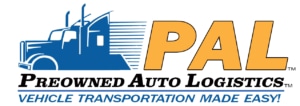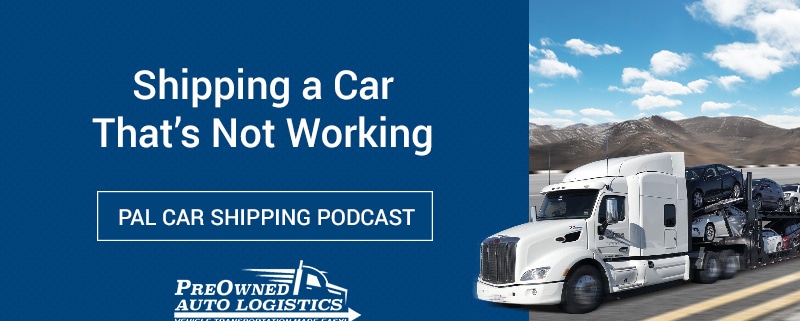Shipping a Car That’s Not Working (Podcast)
Mike Scenna from Preowned Auto Logistics talks with John Maher about shipping vehicles that don’t work. They talk about how to prepare the vehicles for shipping and looking at situations where you may need to choose enclosed vehicle transport for a damaged vehicle.
John Maher: Hi, I’m John Maher, I’m here today with Mike Scenna, sales manager at Preowned Auto Logistics, a car shipping and auto transport and logistics company, in Massachusetts. And today, our topic is shipping a car that’s not working. Welcome, Mike.
Mike Scenna: Hey, John, how are you?
Can You Ship a Car That Doesn’t Work?
John: Good thanks. So, Mike, can I ship a car that’s not running?
Mike: Yes. I actually get asked that question a lot, John. And, I was surprised to find out how many people didn’t think it was possible to ship a car that wasn’t running, across a country, as opposed to just using a tow truck. The answer is yes, you can ship a car across a country that’s not working.
Reasons to Ship a Car That Doesn’t Work
John: So, if you get asked that question a lot, what are some of the reasons that people say why they might want to ship a car that’s not running?
Mike: All kinds of reasons. Probably most common would be a restoration project. There are a lot of people looking for very specific cars out there that they want to add to a collection, or maybe they do as a hobby to rebuild and sell. And, they might not always find one in running condition if they’re looking for something very, very specific. So, they’ll need to get it shipped to their shop, in order to start working on it.
John: Right. So, they’re a buying a car from somebody online or something like that, and it’s maybe in a different State. But, it’s broken down, it’s not running, they want it shipped to them so that they can put it in their garage and be working on it as a project.
Mike: Exactly. Or maybe even it’s so far from running, and it might just have a lot of good parts that are going towards that one that they’re working on.
John: Okay, right.
Mike: When it comes to projects, and especially on the older vintage cars, people need to ship cars that aren’t running all the time. And then, outside of that, someone might have a problem with their car and it’s bad timing, they’re getting ready for a move and they don’t have time to work on it, and they’re going to work on it when they get to the new place. So, they’ll ship it not running. And then, things happen last minute before shipment and a car might not be running. And, you can’t really change the details of your shipment, so you’ll need to ship it, in-op, we call it, and worry about getting it running on the other end.
Vehicle Transport for Dealerships
John: Do you do car moves for dealerships as well? Where maybe a car might not be running and the dealership still wants it and wants to fix it up so they can sell it?
Mike: Yeah, that happens a lot. So, dealers buy cars from auctions, they swap cars with other dealerships, buy from all kinds of sources, and they’re moving cars at a very high rate, there’s a lot of volume. There’s cars that are in the process of being worked on and not necessarily finished that need to get shipped, and they’re not running. Or, they’re getting a car from an auction that might not be running, and they plan on getting it running when it gets to their dealership or their shop. So, that happens. It’s pretty common to ship cars for dealerships when they’re not running, so it’s something we’re used to, and we’ve got a really good process here for doing.
Loading Vehicles on Car Carriers
John: So, how are cars actually loaded on to a car carrier? Or, can they not be loaded on to a car carrier if they’re not running? Do they need a special tow truck, or a flatbed, or something like that?
Mike: Yeah. So, a couple of different ways. For the most part, it is a special truck, it’s very similar to your standard car carrier that you see with the ramp and multiple levels that you would drive the cars onto. The only difference being, these trucks would be equipped with a cable and a wench. So, it’d be a cable that could extend out, attach to the car and pull it up onto the ramps. Just dragging it on, someone would be inside of it operating the steering wheel and the brakes to make sure that it gets on correctly. In some cases, some places are equipped to load these cars. You could use other machinery like forklifts and things like that to actually pick the car up and put it onto the truck, but that would have to be at a place that has that stuff. But for the most part, it’s a truck that’s just equipped with that wench in order to pull the car up onto the truck.
John: I’ve had tow trucks come that are flatbeds, instead of those types of two trucks that pull the car behind it. So, it’d be very similar to a car being pulled onto a flatbed truck, except it’s a larger car carrier that can hold multiple cars?
Mike: Yeah, exactly. It’s that same idea that you have, only it’s on one of those larger carriers. And, it’s the right training. There are people who are trained right for it and do this a little bit more than others who aren’t used to it. Because, again, you’re going onto the truck, it has dips, inclines and declines, it’s not just pulling it right up onto that ramp. There’s making sure you’re stopping it too, at the right time. There’s other cars on the truck. So, you’ve got to… Not only protecting the car that you’re loading, the in-op car that you’re picking up, but you’ve got to make sure you do this right for the safety of the other vehicles on the truck.
Cost of Shipping a Non-Working Vehicle
John: Sure. Is it more or less costly to ship a car that isn’t running?
Mike: Usually, it ends up being more costly to ship a car that’s not running. And, that comes down to a simple supply and demand. They’re just a lot less common, these trucks with the drivers and equipment that are equipped to ship in-op cars. They’re a lot harder to find, so depending on where it’s going, it could take a little bit longer and a little bit more money to find the right truck and team to move the car safely.
How to Prepare a Car for Shipping
John: And, do I have to do anything unusual with a car to get it ready for shipping, if that car is not running, compared to preparing for a move if my car is running?
Mike: You always want to be prepared and careful, and relay as much information about the shipment as possible. But, especially with an in-operational car, you’re really going to want to take that time. Probably take some pictures to provide your transporters, so they know exactly what they’re working with. You’re going to want to let them know the extent of why the car is inoperable, because that’s going to dictate the piece of equipment and the team that’s arriving to move the car. So, they’re really going to want to know what it is about the car that’s preventing it from running or operating.
John: Right. There’d be a big difference between a car where just the engine won’t start, and a car that maybe has been in an accident and part of the body is rubbing up against the wheels. Or something like that, where it would be something functional that would get in the way of them loading it on the truck.
Mike: Right. Like you just said, if something is affecting the wheels… Now, there’s a big difference between the car simply not being able to start vs. it can’t start and can’t roll either.
John: Right.
Mike: And, what’s the extent of this car? How much body damage does it have? Are there parts of the car that are fully exposed to the elements? Then, we need to go in-op and it needs to be closed, because if it’s a long enough trip you don’t want it exposed if it’s missing some windows, or a piece of the roof, or the trunk is gone. So, you really got to take the time to go through exactly why isn’t this car running, and what kind of condition is it in?
Request a Quote on Auto Transport
John: All right, well that’s really great information, Mike. Thanks again for speaking with me today.
Mike: Of course, thanks, John.
John: And, for more information or to request a quote for your auto shipping needs, visit the website at preownedautologistics.com, or call 8775421955.




